One of most striking inhabitants of the African bush is the kudu. These creatures aren’t just another pretty face in the savannah; they’re a symbol of the beauty and resilience of Africa. So, grab your virtual binoculars, and let’s embark on this wild journey to understand the kudu beyond its Instagram-worthy appearance.
What is the Kudu?
The kudu, or as the science folks call it, Tragelaphus, is a name that belongs to not just one, but two types of antelope that call the African wilderness their home. Imagine a creature so enchanting that it gets categorized twice—once as the Greater kudu (Tragelaphus strepsiceros) and again as the Lesser kudu (Tragelaphus imberbis). These majestic beings are the embodiment of African grace, with their long, spiral horns and elegant posture.
Kudus are part of the bovid family, which means they share the family tree with other hoofed herbivores, including the likes of buffalo, bison, and even those domesticated cows. However, make no mistake, kudus are anything but your average farm animal. They’re a symbol of the wild, untamed landscapes of Africa, often featured in folklore and admired for their beauty and strength.
Greater vs Lesser Kudu
Now, let’s break it down: Greater kudus and Lesser kudus—what’s the deal? Well, as their names suggest, size is a significant differentiator. The Greater kudu is the larger of the two, with males standing tall at about 1.4 meters at the shoulder. They’re like the high school basketball players of the savannah, noticeable and imposing. Lesser kudus, on the other hand, are the more petite, agile members of the family, with males reaching about 1 meter at the shoulder. They’re the track stars, if you will, smaller but swift and graceful.
But size isn’t the only difference. Greater kudus are the more sociable of the two, often found in small groups, whereas Lesser kudus are more secretive, sticking to the thickets and being harder to spot. Their habitats also differ, with the Greater kudu preferring woodlands and savannahs, while the Lesser kudu calls the dense bushland and dry riverbeds home.

What do Kudus Look Like?
Picture this: a tall, dignified antelope with a sleek, streamlined body and a head that carries a set of twisted horns so majestic, they could rival any crown. That’s your kudu. Both Greater and Lesser kudus come equipped with these iconic spiraled horns, but only the males. These horns can grow incredibly long, especially in Greater kudus, where they can spiral two and a half times and reach lengths of over a meter!
The kudu’s coat is a beautiful grayish-brown, sprinkled with white stripes that run down their sides—nature’s own camouflage that helps them blend seamlessly into the dappled light of their woodland habitats. They’ve got a white chevron stripe between their eyes, adding to their mystique and charm. The males also boast a beard along their throat, giving them an added air of nobility.
How Big are Kudus?
When it comes to size, kudus are quite the spectacle. The Greater kudu, being one of the tallest antelopes, boasts an impressive height, with males standing up to 1.4 meters (about 4.5 feet) at the shoulder and weighing between 190 to 270 kilograms (420 to 600 pounds).
The Lesser kudu, while not as tall, still commands respect with males reaching about 1 meter (3.3 feet) at the shoulder and weighing around 92 to 108 kilograms (202 to 238 pounds). This size difference isn’t just for show; it plays a crucial role in their survival, from evading predators to competing for mates.
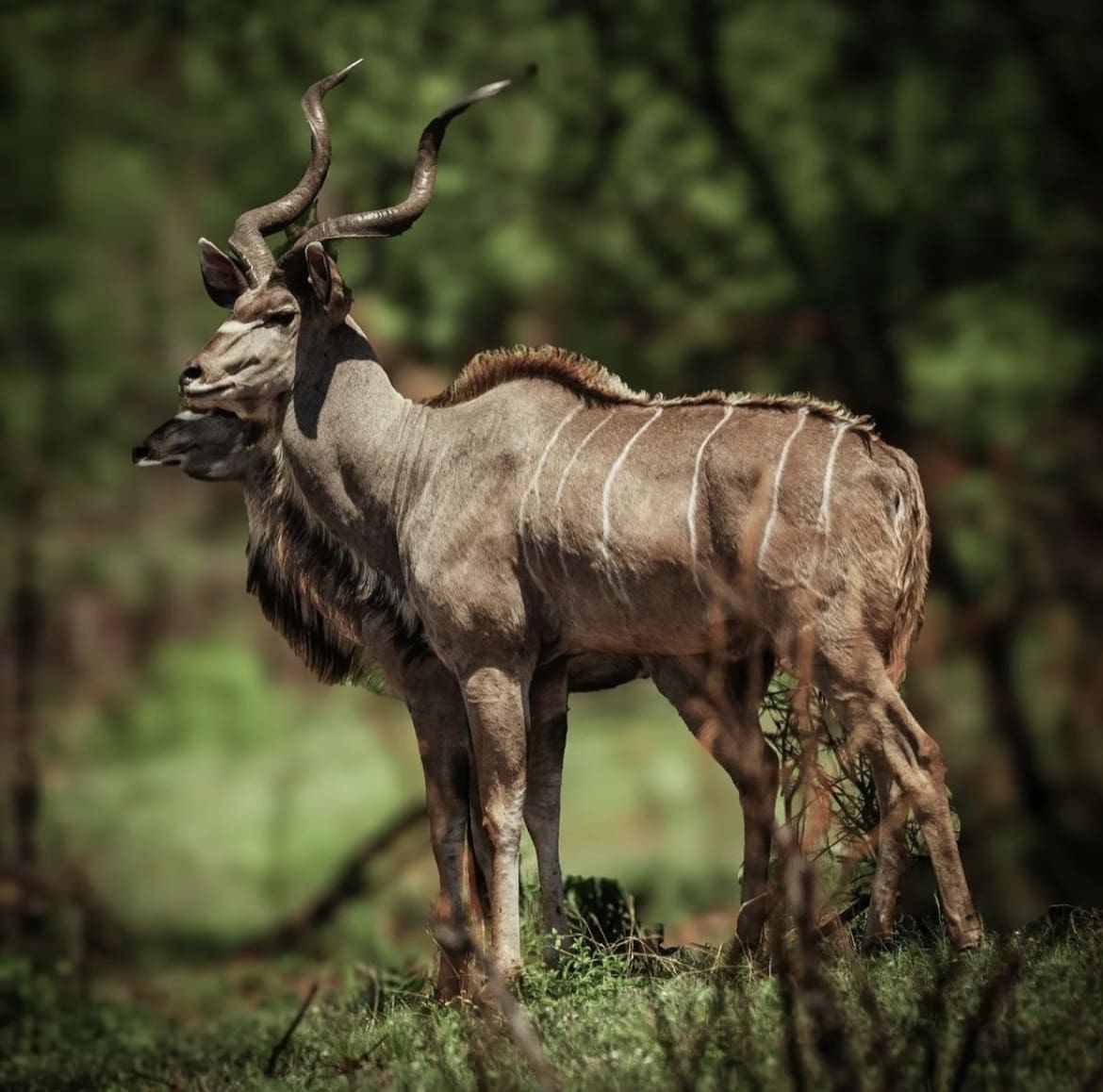
Kudu Skin
It’s not just their impressive size that helps them survive in the wild; their skin plays a significant role too. Kudus have a short, smooth coat that varies from brownish-gray to blue-gray, allowing them to blend into their natural habitats effortlessly.
This camouflage is essential for hiding from predators and sneaking up on the vegetation they feast on. Especially during the heat of the day, kudus often seek shade, and their skin helps them stay nearly invisible among the sun-dappled leaves and branches of the woodland.
Kudu Horns
Ah, the kudu’s horns—truly a marvel of nature. These aren’t just any horns; they’re long, twisted spirals that can reach lengths of up to 1.2 meters (about 4 feet) in Greater kudus, making them some of the most spectacular in the animal kingdom. Each twist of the horn represents years of growth, with the horns starting to spiral at around two years of age and continuing to grow throughout the kudu’s life.
But these horns aren’t just for show. In males, they’re a vital tool for defense against predators and rivals. During mating season, male kudus will lock horns in a display of strength and dominance, a dramatic duel that can sometimes be a matter of life and death. Yet, despite their imposing appearance, the horns are also a vulnerability, as they can get tangled in trees or bushes, making the kudu an easier target for predators.
The horns of the Lesser kudu, while shorter and less spiraled than those of their Greater counterparts, are no less impressive. They embody the same majestic curve and purpose, standing as a testament to the kudu’s resilience and grace in the face of challenges.
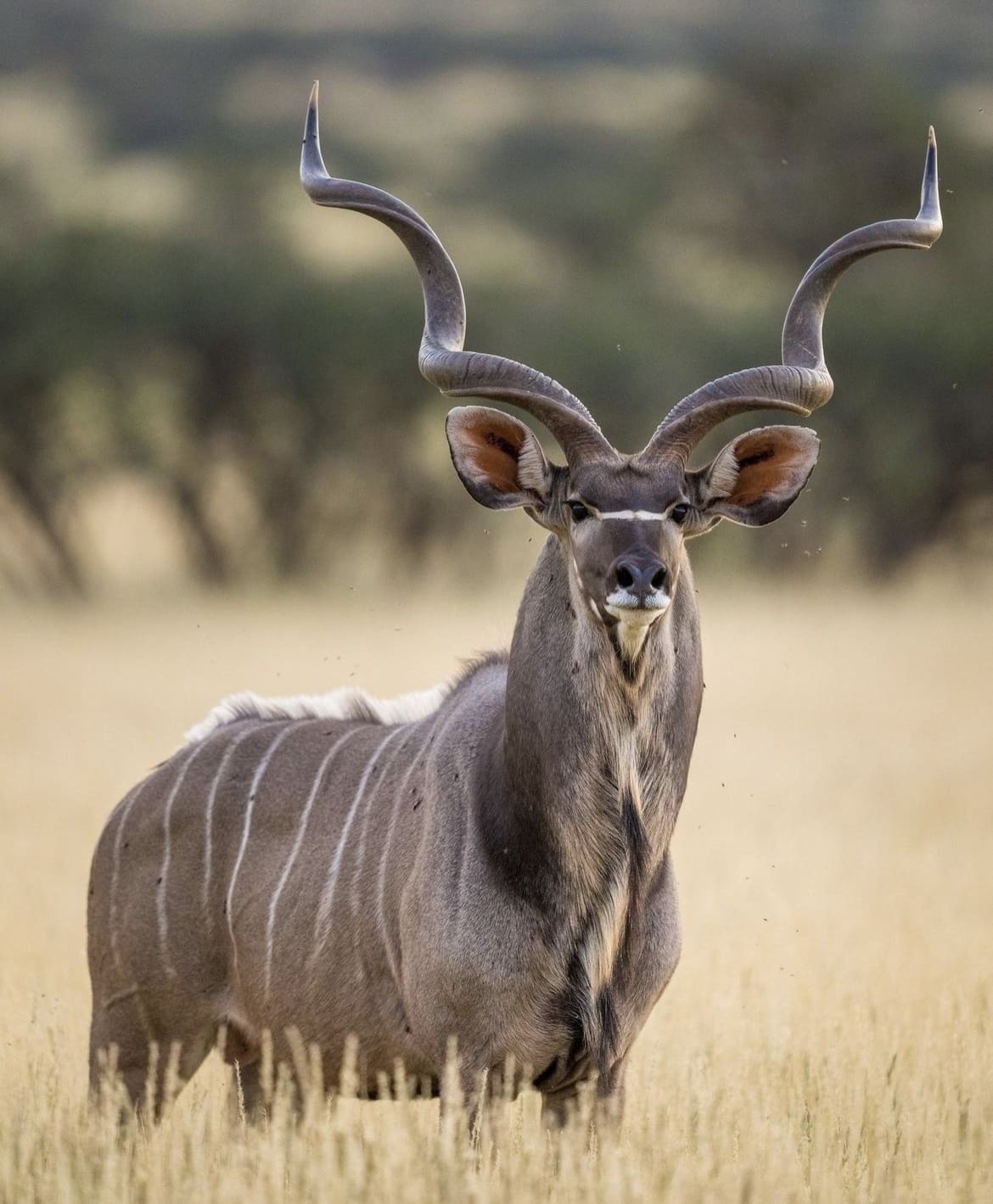
Kudu Colouration
Kudus are masters of disguise, thanks to their unique coloration. Their grayish-brown coats provide a perfect backdrop for the white stripes that adorn their sides. These stripes, along with spots and a distinct white belly, are not random decorations; they’re essential for survival. This pattern breaks up the kudu’s outline, making it harder for predators like lions, leopards, and hyenas to spot them among the trees and shrubs of their habitat.
Even more intriguing is the white chevron mark between their eyes, enhancing their camouflaged appearance and adding an extra layer of mystique to their already captivating presence.
What do Kudus Eat?
Kudus may look like they’re built for the runway, but when it comes to dining, they’re all business. These antelopes are browsers, not grazers, meaning they prefer to munch on leaves, flowers, and fruits rather than grass. Their diet includes a variety of vegetation, from acacia trees, which are a favorite, to wild fruits and flowers that they can reach with their long necks.
This diet is rich in nutrients and moisture, which is crucial for survival in their often arid habitats. Interestingly, kudus are known to travel great distances to find water during the dry season, but they can also go for long periods without drinking, relying on the moisture from their food.
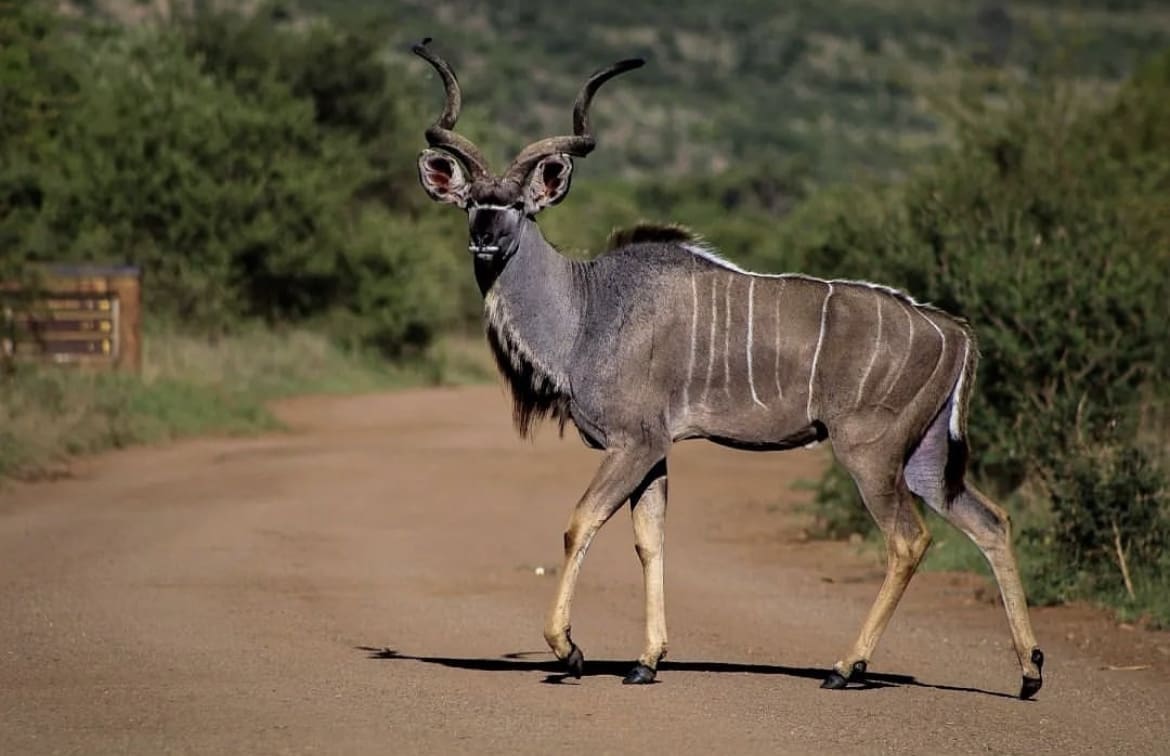
Kudu Social Structure
When it comes to social life, kudus are quite the interesting characters. Greater kudus tend to be more sociable than their Lesser counterparts, forming small groups, especially in the case of females and their offspring. These groups are matriarchal, led by a dominant female, and provide safety in numbers from predators. Males, however, are more solitary or form bachelor groups, only joining the females during the mating season.
Lesser kudus, on the other hand, are more secretive and tend to keep to themselves or in pairs, perhaps due to their smaller size and the denser habitats they occupy. This behavior helps them stay hidden from predators and humans alike. Regardless of their size, both types of kudus maintain a certain level of secrecy, which, combined with their excellent camouflage, makes them one of the more elusive and fascinating antelopes to observe in the wild.
How do Kudus Reproduce?
Kudus have a fascinating approach to reproduction, characterized by a subtlety that matches their elusive nature. The mating season, or rut, occurs towards the end of the rainy season, when food is plentiful, and the animals are well-nourished. During this time, male kudus become more territorial and display their magnificent horns in dramatic battles for the right to mate with females. Despite these displays, kudu fights are more about show than actual combat, with males preferring to intimidate rather than engage in dangerous conflicts.
After a gestation period of about 7 to 8 months, female kudus give birth to a single calf, which they hide in dense vegetation for the first few weeks of its life to protect it from predators. This strategy underscores the kudu’s emphasis on stealth and survival from the very beginning of life. Calves are weaned after about six months but may stay with their mothers for up to two years, learning the intricacies of navigating their environment.
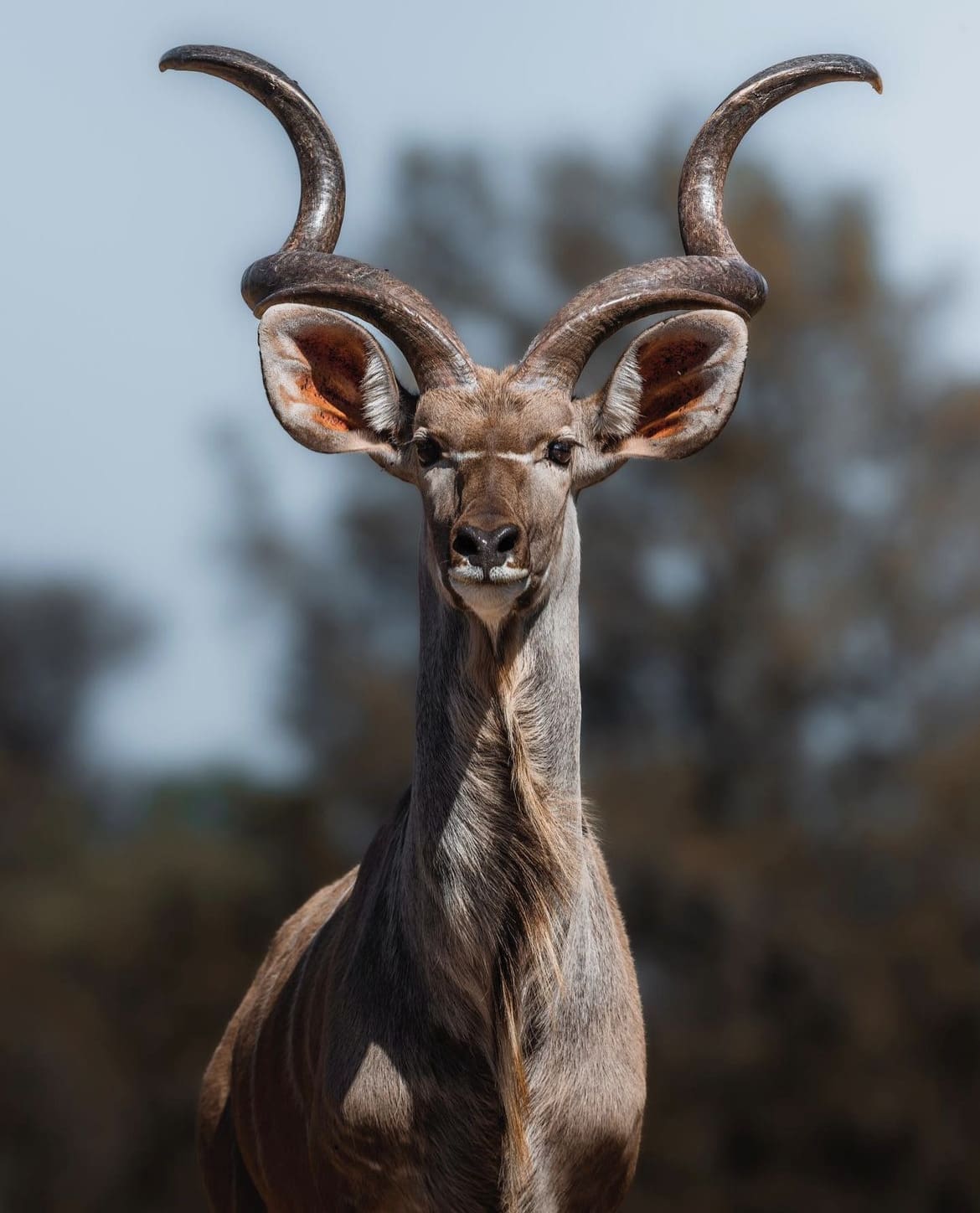
How Long do Kudus Live?
In the wild, kudus can live up to 7-8 years, though some have been known to reach the ripe old age of 15 under ideal conditions. However, their lifespan is significantly influenced by the presence of predators, human activities, and environmental factors.
In protected reserves and zoos, where threats from predators and poaching are minimized, kudus can live longer, showcasing the impact of conservation efforts on their survival rates.
Are Kudus Aggressive?
By nature, kudus are not aggressive creatures. They are, in fact, quite the opposite, embodying a cautious and reserved demeanor that helps them avoid conflicts. However, like any wild animal, kudus can become defensive if cornered or threatened, especially males during the mating season.
Their primary defense mechanism is flight rather than fight, relying on their keen senses and agility to escape potential dangers. When it comes to human encounters, kudus are more likely to flee than confront, making aggressive encounters extremely rare.
Are Kudus Territorial?
Kudus exhibit a fascinating blend of territorial and non-territorial behavior. During the mating season, male Greater kudus become more territorial, using their majestic horns to spar with rivals and establish dominance over a particular area. This behavior is primarily geared towards attracting females and is often accompanied by loud barking sounds that serve as warnings to other males. However, outside of the breeding season, males tend to be less territorial and may even form loose bachelor groups, showcasing a flexible approach to territory based on social and environmental cues.
Lesser kudus, on the other hand, display a more consistently non-territorial nature, possibly due to their smaller size and the dense habitats they prefer. They rely more on stealth and camouflage to protect themselves and their offspring, rather than defending a specific territory.
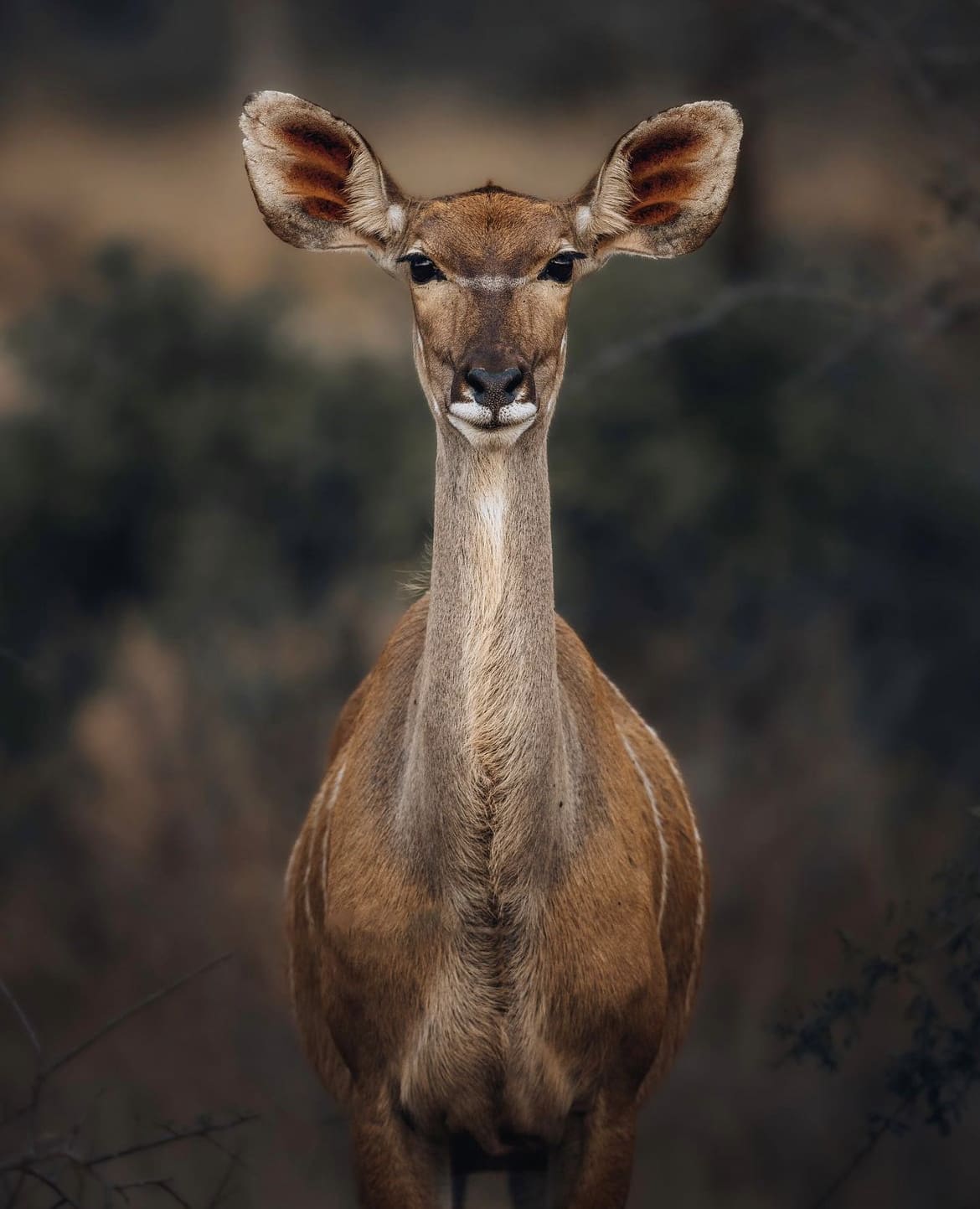
How Fast are Kudus?
When it comes to speed, kudus may not be the fastest animals on the savannah, but they are certainly no slouches. Capable of reaching speeds up to 60 km/h (about 37 mph), they can make a quick getaway when threatened. However, their real strength lies in their agility and the ability to navigate through dense vegetation with ease.
Their long legs and powerful bodies allow them to leap great distances and even clear fences over 2 meters (about 6.5 feet) high. This combination of speed and agility makes them formidable escape artists, often eluding predators with their acrobatic prowess.
Where do Kudus Live?
Kudus are found in a variety of habitats across Africa, from the dry, thorny savannahs to the dense woodlands and hillsides. Greater kudus have a wider range, extending from the east of Africa down through the southern savannahs and woodlands, avoiding the desert regions. They require access to both cover and water, making them more prevalent in areas with dense bush or forest patches.
Lesser kudus are more restricted to the arid and semi-arid areas of East Africa, favoring the dense bushland and dry riverbeds that provide both camouflage and sources of food. Despite their different preferences, both species have adapted remarkably well to their respective environments, utilizing their unique physical and behavioral traits to thrive in a variety of conditions.
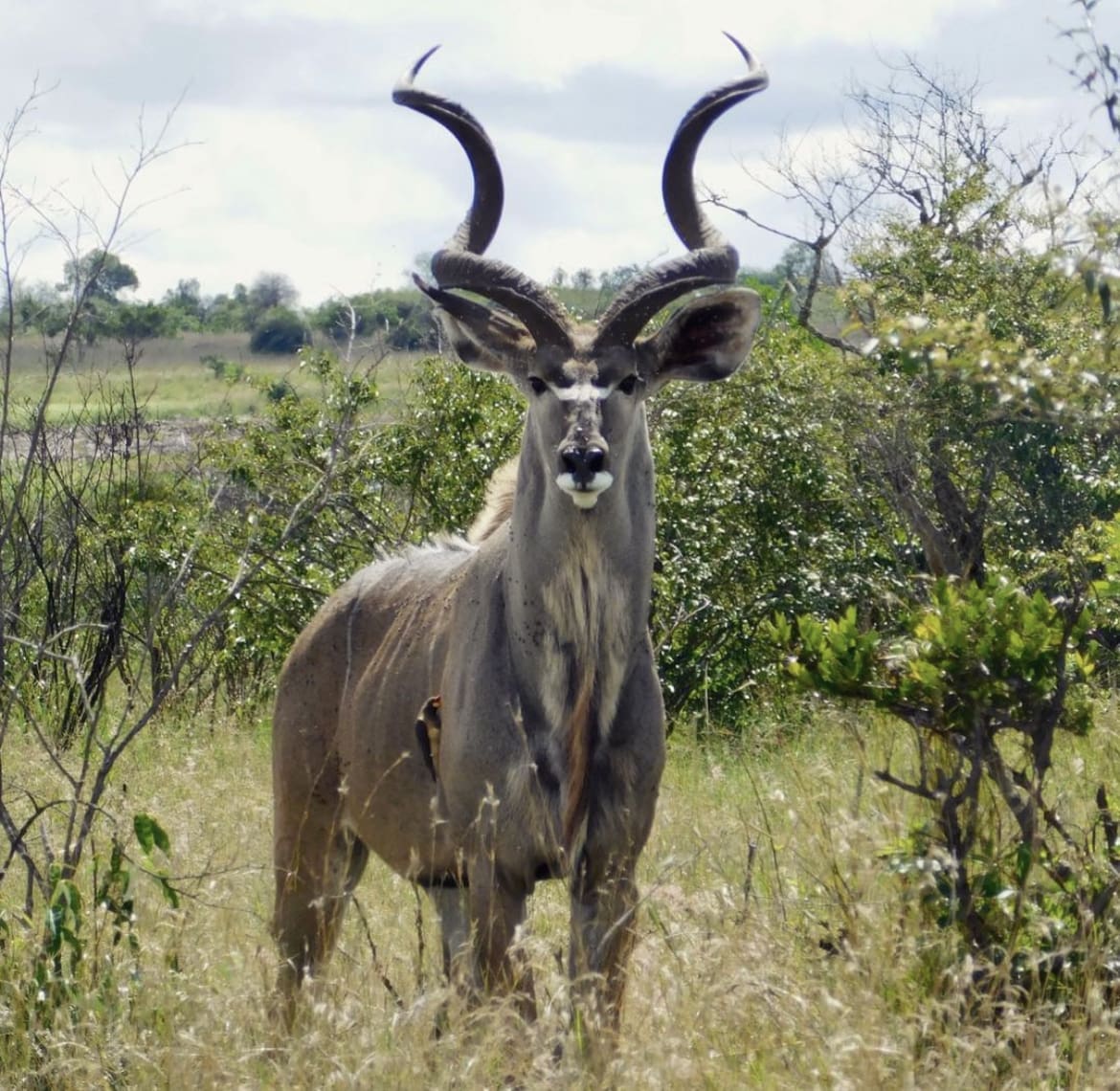
How Many Kudus are there in the Wild?
The population of kudus, both Greater and Lesser, varies across Africa, influenced by habitat availability, predation, and human activities. The Greater kudu, with its wider range, tends to have a larger, though fragmented, population. Estimates suggest tens of thousands exist, but accurate numbers are hard to pin down due to their elusive nature and the vast, often inaccessible areas they inhabit.
Lesser kudus have a smaller population, primarily due to their more restricted habitat preferences and the ongoing threats of habitat destruction and hunting. While specific numbers are challenging to determine, their population is believed to be under greater pressure, leading to concerns about their long-term viability in the wild.
Are Kudus Endangered?
Currently, the Greater kudu is classified as “Least Concern” by the International Union for Conservation of Nature (IUCN), thanks to its relatively stable population in protected areas. However, this status does not mean they are free from threats, and certain populations, especially those outside protected areas, are declining.
The Lesser kudu is classified as “Near Threatened,” reflecting the increased risks it faces from habitat loss, hunting, and competition with livestock. Their more specialized habitat requirements make them more vulnerable to environmental changes and human encroachment.
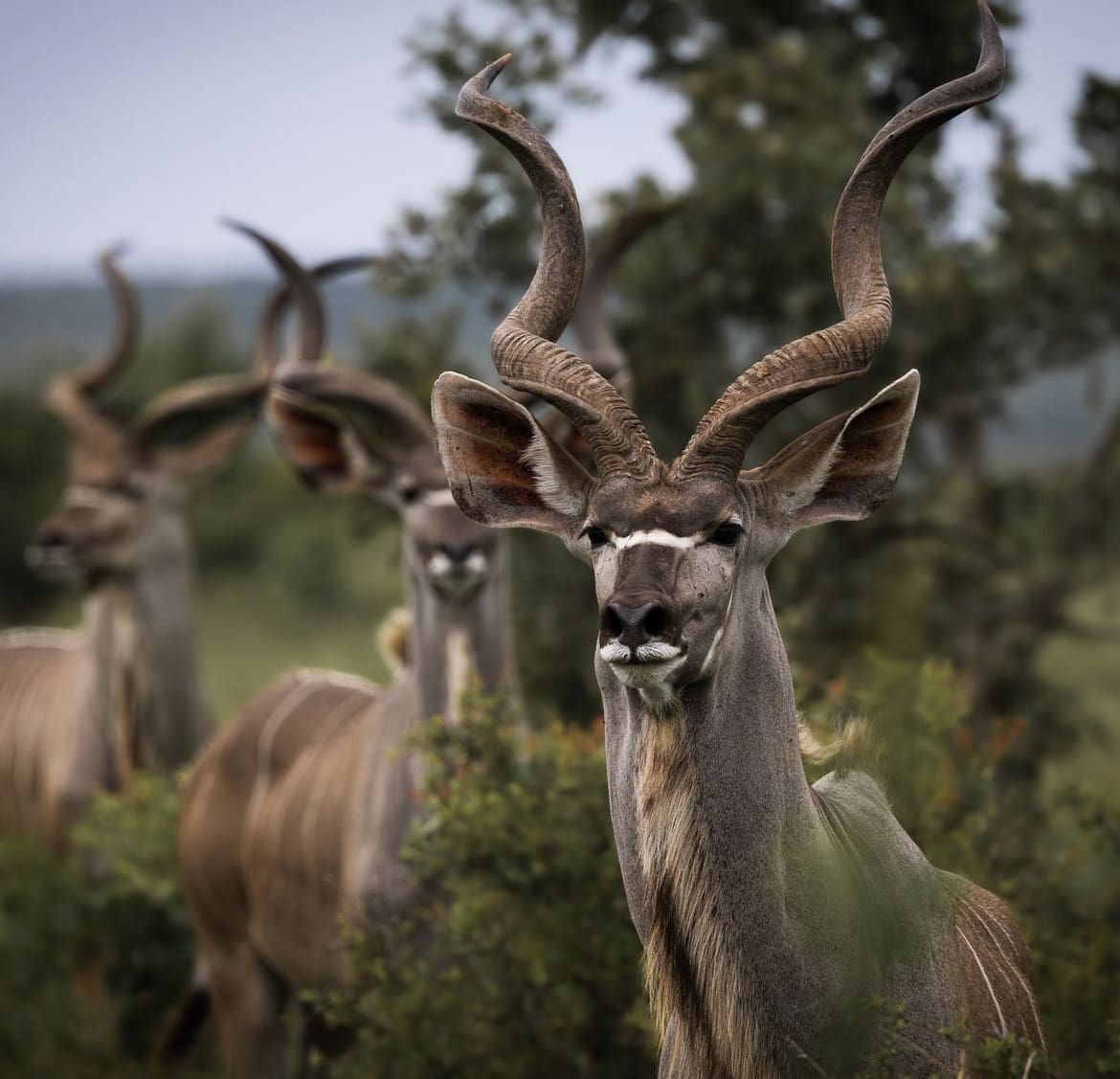
Threats to Wild Kudus
Kudus face several threats in their natural habitats, primarily from human activities and environmental changes. Habitat loss due to agricultural expansion, deforestation, and human settlement is a significant threat, fragmenting populations and reducing access to essential resources like food and water.
Poaching and hunting for their meat and magnificent horns also pose a risk, particularly for Lesser kudus, which are prized by hunters. In addition, competition with livestock for grazing areas and water can lead to conflicts with humans, further exacerbating the pressures on their populations.
Natural predators, including lions, leopards, and hyenas, are a constant threat, especially to younger or weaker individuals. However, it is the human-induced threats that present the most significant challenges to the survival of kudus in the wild.
Where to See Kudus in the Wild
For wildlife enthusiasts and nature lovers, observing kudus in their natural environment is a memorable experience. These antelopes can be found in several national parks and reserves across Africa, where they roam freely in protected landscapes.
Some of the best places to see Greater kudus include Kruger National Park in South Africa, Etosha National Park in Namibia, and Tsavo National Park in Kenya. Lesser kudus, with their preference for more arid regions, are best spotted in places like Samburu National Reserve and Tsavo East National Park in Kenya.
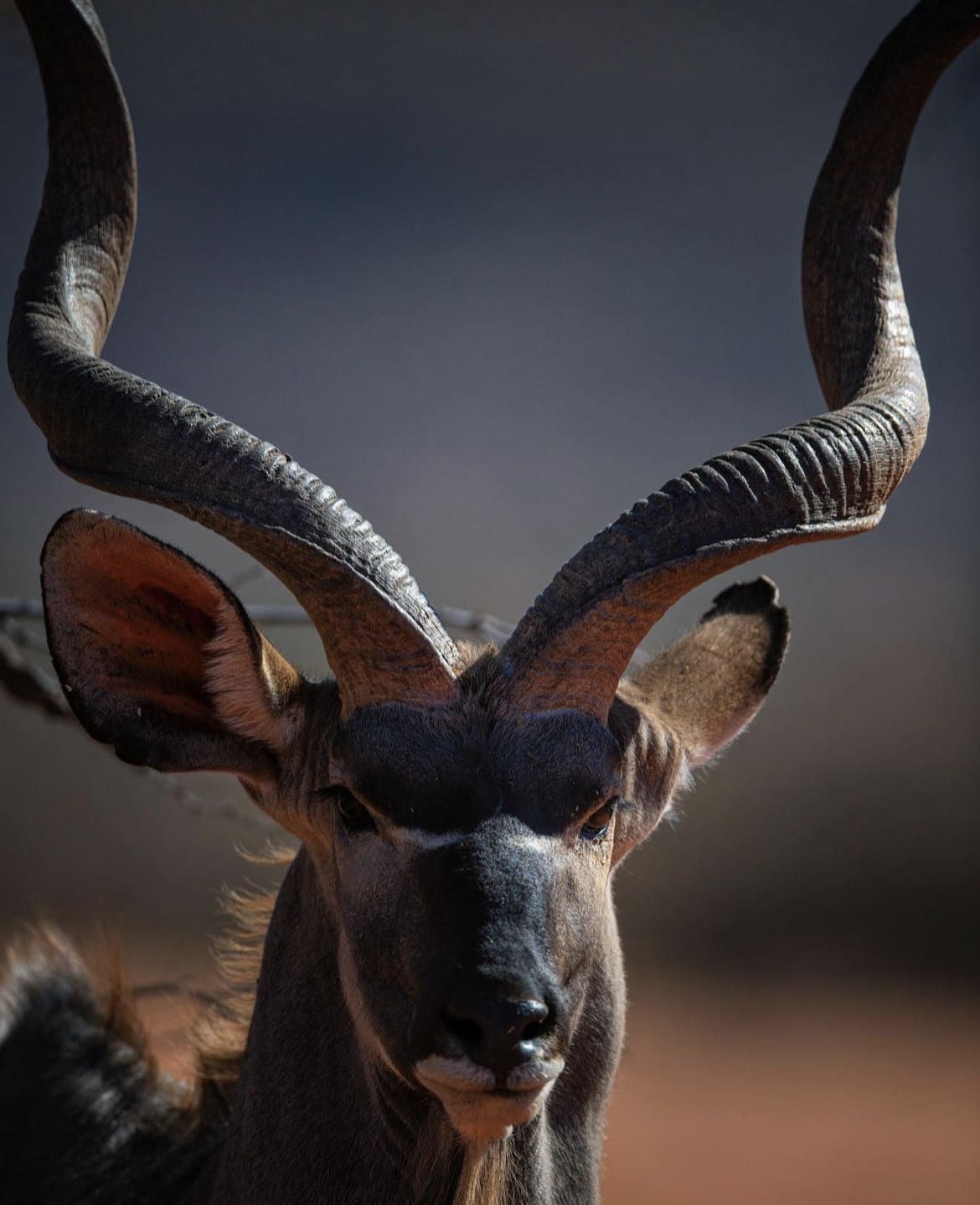
Tips for Spotting Kudus in the Wild
Spotting kudus, especially the elusive Lesser kudu, can be a challenge, but a few tips can increase your chances of a sighting. Early morning or late afternoon, when kudus are most active, is the best time for wildlife watching.
Look for them in areas with dense brush or woodland edges where they come to feed. Being quiet and patient is key, as kudus are skittish and easily spooked by loud noises or sudden movements.
Facts about The Kudu
- Kudus have one of the longest horns of any antelope, with Greater kudu males sporting horns that can spiral two and a half twists.
- They are excellent jumpers, capable of clearing heights of over 2.5 meters (8 feet) when fleeing from predators or obstacles.
- Kudus are predominantly browsers and have a diverse diet, which includes leaves, fruits, and flowers from over 100 different plant species.
Myths about The Kudu
- Myth: Kudus can interbreed with other antelope species to create hybrid offspring. Fact: While kudus share the savannah with many other antelope species, they do not interbreed with them. Kudus can only successfully mate with their own species.
- Myth: The horns of kudus are used as musical instruments. Fact: While it is true that the horns of dead kudus can be hollowed out and used as instruments in some cultures, this is not a widespread practice and certainly not the reason kudus grow their horns.
